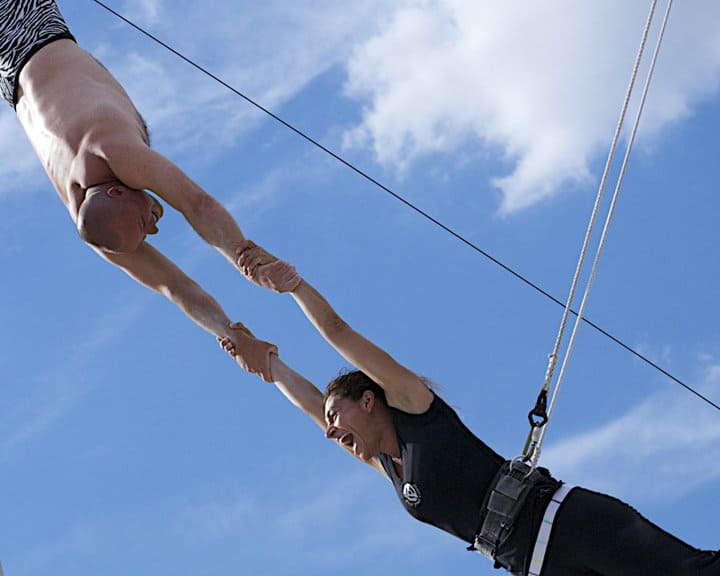Though it may seem like a random journey from trick to trick sometimes, there is, in fact, method to the madness. At TSNY, we have a carefully developed curriculum that is aimed at developing essential skills alongside your trick-to-trick progression. The overarching goal is to help you to become the best and most capable flyer you can be. Along the way, we encourage you to develop an awareness of standard practices and safety, so that you can take an increasing level of ownership of your flying as you progress to higher and higher levels. The goal of this segment will be to peak behind the curtain, so to speak, to clarify just what key skills and concepts you should be taking away from trick that you practice.
Believe it or not, we begin our agenda of teaching important skills right away with the knee-hang and the backflip. As you may have heard on your first day, in flying trapeze there are basically two types of tricks: catchable tricks and dismounts. We start your trapeze journey off with one of each. For your knee-hang to be catchable, you need to movement into position with the right timing. This represents the beginning of the process of learning the art and science of movement timing within the swing. From the ‘scientific’ standpoint, your movements for the knee-hang need to happen at either peak of the swing. The ‘art’ is that the upward parts of the movements happen as you finish going up into peak and the downward parts of the movements should happen just as you descend out of peak. The backflip asks you to spread three kicks out over one swing. Doing all of this well requires ‘feel’ for where you are in the swing. We don’t expect you to nail the ‘art’ in your first class, but we’re introducing this concept here for good reason. It’s a concept that will follow you through most of the tricks you’ll ever learn.
Perhaps the more obvious skill that you come out of your first class with is that of presenting good catch hands. When in doubt, fingers out. It’s such a simple thing, but well-presented catch hands are one of the most fundamental pre-requisites for a good catch. It seems simple enough, but the real trick lies in putting your hands where they need to be and allowing the catcher to do his or her job (which is catching you). Remember: flyers fly and catcher catch. The catch isn’t everything in your first class, but it sure does make for some good ‘icing on the cake’.
Next month, we’ll explore Level 2 of our curriculum and the importance of being tight as you come off the bar. In the meantime, if you’ve got questions about the curriculum or your progress through it, please feel free to ask one of your friendly neighborhood TSNY instructors for some insight. We’d be happy to talk it through with you!

